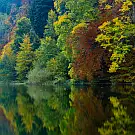File Size & Compression Calculator for Image Formats
Find the perfect balance between image quality, display speed, and storage space
With this calculator, you can quickly and easily estimate the prospective file size and the effects of various compression settings for image formats like TIFF, JPG, WebP, PNG, and many others. Enter dimensions, color depth, and desired complexity or quality to find the optimal format and the best balance between file size and visual quality for your needs! Use our preview to directly assess compression artifacts. For detailed conversions between pixels, DPI, and length units, as well as the underlying formulas, visit our comprehensive Pixel Calculator.



Top Results
| Format | Quality | Size % | File Size |
|---|---|---|---|
| TIFF | - | 100% | 8.58 MB |
| JPEG XL | 64% | 6 - 8% | 0.55 - 0.67 MB |
| AVIF | 67% | 7 - 8% | 0.57 - 0.69 MB |
| HEIC | 69% | 8 - 10% | 0.71 - 0.87 MB |
| WebP | 71% | 8 - 10% | 0.72 - 0.88 MB |
| JPEG | 75% | 15 - 18% | 1.25 - 1.53 MB |
Detailed File Sizes: Effects of Format, Compression & Quality (based on Pixels, Color Depth & DPI)
| Format | Quality | Size % | File Size |
|---|---|---|---|
| JPEG | 75% | 15 - 18% | 1.25 - 1.53 MB |
| PNG | Level 2 | 64 - 78% | 5.49 - 6.71 MB |
| TIFF (uncompressed) | - | 100% | 8.58 MB |
| TIFF (LZW) | LZW | 54 - 66% | 4.63 - 5.66 MB |
| WebP (lossless) | - | 36 - 44% | 3.09 - 3.78 MB |
| WebP (lossy) | 71% | 8 - 10% | 0.72 - 0.88 MB |
| HEIC | 69% | 8 - 10% | 0.71 - 0.87 MB |
| GIF - 256 Colors | - | 59 - 72% | 1.67 - 2.05 MB |
| RAW (uncompressed) | - | 100% | 5.01 MB |
| RAW (lossless compressed) | - | 30 - 36% | 1.49 - 1.82 MB |
| RAW (C-RAW) | 74% | 51 - 63% | 2.57 - 3.15 MB |
| DNG (compressed) | - | 54 - 66% | 2.70 - 3.30 MB |
| DNG Linear (lossless, 48 Bit) | - | 100% | 17.2 MB |
| AVIF (lossless) | - | 36 - 44% | 3.09 - 3.78 MB |
| AVIF (lossy) | 67% | 7 - 8% | 0.57 - 0.69 MB |
| JPEG XL (lossless) | - | 34 - 41% | 2.90 - 3.54 MB |
| JPEG XL (lossy) | 64% | 6 - 8% | 0.55 - 0.67 MB |
| BMP Uncompressed | - | 100% | 8.58 MB |
Ready to figure out your image’s file size? Awesome! Curious about how it works and what it means for your projects? Dive into our helpful tips and answers to common questions below.
More than just numbers: Interesting facts about image file sizes and formats like JPG, WebP, AVIF ... to TIFF
Why is the file size of images important?
Our calculator shows you how image formats impact file size, which affects loading speeds for websites, apps, or documents. Newer formats shrink files while keeping images sharp, thanks to smarter compression techniques.
| Context | Format Comparison | Volume Saving | Quality |
|---|---|---|---|
| Website (Desktop/Mobile) | WebP instead of JPEG | approx. 30 – 50% less | sharper details and fewer artifacts |
| App Integration | WebP instead of PNG | approx. 60 – 80% smaller | smoother gradients without banding |
| Documentation (PDF/Print) | AVIF instead of JPEG | approx. 40 – 60% less | higher contrast fidelity, better color reproduction |
The most common image formats at a glance
| Format | Advantages | Disadvantages |
|---|---|---|
| JPEG (JPG) | High compression, wide support | Lossy, visible artifacts at high compression |
| PNG | Lossless, transparency support | Large file sizes for photos |
| TIFF | High print quality, lossless option | Very large files, hardly any web support |
| WebP | Good compression (lossy & lossless), modern all-round format | Not fully supported in older browsers/tools |
| HEIC | Efficient compression, high image quality | Proprietary, mainly in the Apple ecosystem |
| GIF | Animations possible, small icons | Only 256 colors, inefficient for photos |
| RAW | Maximum image information, ideal for post-processing | Very large files, not directly usable on the web |
| AVIF & JPEG XL | Very high efficiency, better quality with smaller volume | Support still limited, new to the market |
| BMP | Simple structure, without compression | Huge files, outdated |
Compression: The key to file size
Lossless compression shrinks files without losing quality (think PNG or TIFF LZW). Lossy compression cuts out some details for smaller files (like JPEG or WebP Lossy), but you can tweak the quality.
Pixels, DPI, and the right resolution
Pixels (px) make up your image. DPI (Dots Per Inch) matters for printing (300 DPI is typical), but on the web, pixel size is key. Try our Pixel Calculator to convert units easily and explore formulas for pixels to DPI, pixels to mm, DPI to mm, and more!
Understanding color depth
Color depth (bits) sets how many colors your image can show. 24 bits (8 bits per channel) is common for photos. Higher depths, like 48 bits, give richer colors but create bigger files.
Image Type: The major influence on file size
Note: Check out three images with the same pixel size to see how compression really works.
| Image Type | Properties & Compression |
|---|---|
 |
Bird on a plain background Large homogeneous areas, few details Example file size (WebP): 0.6 KB → strong file reduction |
 |
Portrait of a child Subtle color gradients (skin tones, hair) Example file size (WebP): 1.7 KB → medium file size |
 |
Autumn lake scene with reflection Many colors & fine structures (leaves, reflections) Example file size (WebP): 5.9 KB → less efficient compression |
FAQ: Image Formats for Various Applications
Pick the perfect image format to make your project shine! Discover the best formats for websites, apps, print, and presentations below.
Which image format is best for my website (Desktop & Mobile)?
For your website (desktop & mobile), you're looking for the optimal balance between image quality and loading time – this boosts your user experience and SEO. We strongly recommend primarily using WebP. Use JPEG and PNG as robust fallbacks.
A typical portrait TIFF image of 12.4 MB serves as a reference. Here you can see how common web formats affect it with standard compression settings (all file sizes are approximate):
| Format | Transp. | % | MB |
|---|---|---|---|
| WebP | ✔️ | 9% | 1.17 |
| JPEG | 16.5% | 2.01 | |
| PNG | ✔️ | 71% | 8.82 |
| SVG | use for logos & icons | ||
You see: WebP often delivers the most aggressive compression with good visual quality for photographic content. For graphics with transparency where you don't want to compromise on quality, lossless WebP is a more performant alternative to PNG.
"WebP Fallback" – What is it and how do you implement it?
A "fallback" ensures that your images are also displayed in old browsers that do not understand newer formats like WebP, by automatically loading an older alternative (e.g., JPEG). This ensures that all your users can see the content, regardless of their browser version.
Attention: WebP and your Content Management System (CMS)
Although modern browsers widely support WebP, your CMS, theme, or certain plugins might not process WebP seamlessly. Check compatibility!
Which image formats for Graphical User Interfaces (GUI) in Apps & Desktop Applications?
PNG and lossless WebP are common for icons and UI elements, especially with transparency. SVG is ideal for scalable graphics. HEIC/HEIF is relevant in the Apple ecosystem. Pay attention to pixel-perfection and performance.
Which image formats for Print (Printed Materials)?
TIFF is the industry standard. PSD for working files. EPS for vector graphics. PDF as the final format. JPEG only with the highest quality. Important: Min. 300 DPI, CMYK color mode.
Which image formats for Presentations?
JPEG for photos, PNG for diagrams/logos/transparency. WebP, if supported. GIF for simple animations. Adjust the resolution to the display.
FAQ: Creation, Conversion & Compression Basics
Want top image quality with the smallest file size? Learn the basics of creation, conversion, and compression. Find answers to the most common questions below!
From which source format should I convert to achieve the best quality?
Always start with the best possible quality (e.g., TIFF, PNG, RAW). Avoid converting from an already heavily compressed, lossy format to another lossy format.
Can incorrect conversion lead to larger files and/or poorer quality?
Yes. Converting from compressed to lossless can bloat files. Multiple lossy compressions successively degrade quality.
Why do compression results and file sizes vary so much depending on the image subject?
Simple subjects (large color areas, few details) can be compressed better than complex subjects with many details and textures. The image type selection in the calculator attempts to account for this.
What exactly do 'lossy' and 'lossless' mean in image compression?
Lossless: Reduces file size without quality loss; the original can be 100% restored (e.g., PNG). Lossy: Selectively removes image information for stronger compression; quality loss is present but often controllable (e.g., JPEG).
FAQ: Future of Image Formats & Archiving
Digital images keep evolving! Discover what’s next for image formats and how to safely store your precious photos for years to come.
Are new, even better image formats currently being developed?
Yes, continuously. Goals include better compression, more features, and royalty-free licensing. AVIF and JPEG XL are examples of newer formats with high efficiency.
Can image formats 'die out' or become unusable over time?
Yes, especially less popular or proprietary formats. However, widely used formats like JPEG, PNG, TIFF are very durable. For archives, rely on open formats.
Which image formats are best suited for long-term archiving?
TIFF (uncompressed/lossless), PNG (for graphics), DNG (for RAW data) are good choices for maximum quality preservation. Avoid lossy formats like JPEG as the primary archive format for originals.
Quick note: On which data storage should I copy my image archives?
Follow the 3-2-1 rule: 3 copies, on 2 different media, 1 copy off-site. Suitable options include external hard drives, NAS, cloud storage, optical media (M-DISC). Regularly check and migrate!
We’re confident this info will help you understand the calculator and choose the ideal image format and settings for your needs! Try the calculator now and find the perfect solution for your images.